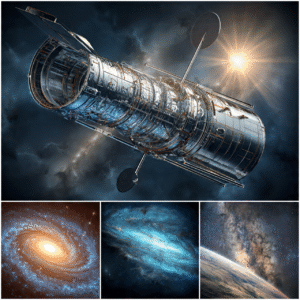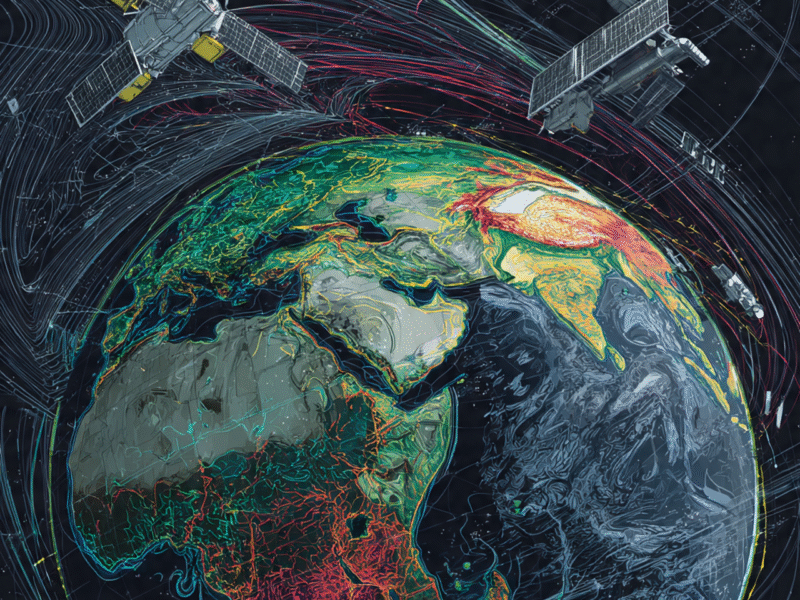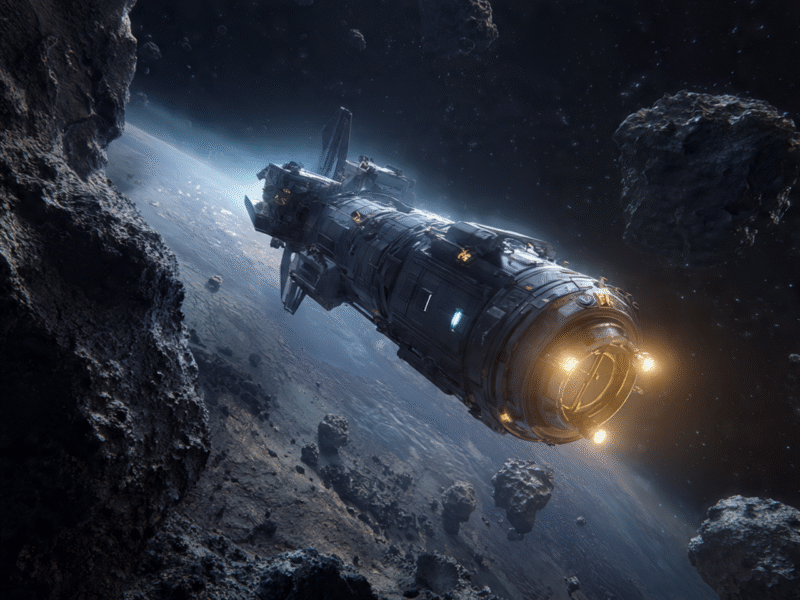Today, I am presenting to you a unique and comprehensive piece on space telescopes, being written for the first time in the world.

This writing will tell you how space telescopes are unveiling cosmic mysteries, sparking global curiosity, and reshaping humanity’s understanding of existence. If you like this material, please let us know, and if you need more details on any specific topic, you can contact us.
🔭 The Revolutionary Journey of Space Telescopes: From Earth to the Cosmos
Space telescopes have fundamentally transformed the scope of knowledge and discovery in human history. They are not merely instruments but masterpieces of humanity’s efforts to understand the universe. When we view the cosmos through the eyes of the Hubble Space Telescope, we are essentially traveling back in time, because light takes millions and billions of years to reach us. These telescopes not only provide us with images of stars and galaxies but also offer us a chance to glimpse into the past of the universe. Since its deployment, the Hubble Telescope has brought revolutionary changes to our understanding of the cosmos. It confirmed that the universe is continuously expanding, verified the existence of black holes, and provided us with information about distant galaxies that was inaccessible to ground-based telescopes. Hubble’s successes paved the way for the James Webb Space Telescope, the most powerful space telescope to date. The James Webb Telescope observes the universe in infrared light, allowing it to see galaxies hidden behind clouds of gas and dust. This telescope is telling us about the formation of the very first stars and galaxies and might even tell us if life exists elsewhere in the universe. This journey of space telescopes is a testament to humanity’s curiosity and thirst for knowledge. They teach us how, despite limited resources and capabilities, we can strive to understand the mysteries of the infinite universe. Each new telescope, each new mission, expands our circle of knowledge and makes us realize how small we are, while simultaneously highlighting the vastness of our thinking capacity.
The journey of the invention and development of space telescopes is a story of human determination and courage. The path from the first telescope to today’s most advanced space telescopes is a masterpiece of science, technology, and human endeavor. These telescopes open doors to the wonders of the universe not only for scientists but also for ordinary people. When we look at images taken by space telescopes, we feel that we are part of this vast cosmos, and this feeling broadens our thinking. Space telescopes have proven that the reach of humanity knows no bounds, and if we wish, we can transcend Earth’s limits and comprehend the entire universe. These telescopes give us hope that future generations can reach the stars and unravel the greatest mysteries of the cosmos. The journey of space telescopes will continue, and each new telescope will deepen our understanding of the universe. This journey is, in fact, humanity’s endless journey of knowledge and curiosity, which will never cease.
🌌 Unveiling Cosmic Mysteries: Journey to the Dawn of Time
Space telescopes have helped us understand the deepest mysteries of the universe. The James Webb Space Telescope has given us a chance to peer into the earliest moments of the universe when the first galaxies and stars were coming into existence. This telescope is telling us how the universe began and how it expanded and evolved. Studying the universe immediately after the Big Bang was not possible for ground-based telescopes, but space telescopes have made this impossible possible. These telescopes are also helping us understand mysterious phenomena like dark matter and dark energy, which constitute 95% of the universe but we cannot see them directly. Observations from space telescopes have told us that the universe is not only expanding but the rate of its expansion is increasing, due to dark energy. This discovery challenges our fundamental understanding of physics and paves the way for new physical theories.
Space telescopes have also played a revolutionary role in the discovery of exoplanets. The Kepler Space Telescope discovered thousands of exoplanets, some of which are Earth-like and have conditions suitable for life. This discovery forces us to think: Are we alone in the universe? The TESS telescope is now discovering more exoplanets, and future missions will study the atmospheres of these planets to try to find out if life exists there. Space telescopes have also played a key role in the study of black holes. The Event Horizon Telescope took the first-ever image of a black hole, but space telescopes have deepened our understanding of these mysterious objects. These telescopes tell us how black holes influence the formation and evolution of galaxies.
Space telescopes have also helped us understand the structure of the universe. These telescopes show us how galaxies are organized in a cosmic web, where filaments of dark matter connect galaxies to each other. These observations help us understand the large-scale structure of the universe. By observing phenomena like gravitational lensing, space telescopes have also provided us with information about the distribution of dark matter. All these discoveries are not only increasing our knowledge but are also forcing us to think about what the true nature of the universe is. The journey of space telescopes is, in fact, a journey in search of reality, helping us find answers to the biggest questions about the cosmos.
🌠 Sparking Global Curiosity: The Link Between Science and Society
Space telescopes have sparked curiosity about the universe not only among scientists but also among the general public. When the first images from the Hubble Telescope were released, excitement was generated all over the world. People saw distant galaxies, nebulae, and star clusters so clearly for the first time. These images were not only beautiful but also forced people to think about where we stand in this vast universe. Space telescopes have also played a key role in the popularisation of science. Hubble’s images go viral in newspapers, magazines, TV shows, and social media, which makes ordinary people interested in science. These telescopes encourage the younger generation to build careers in science and technology.
Space telescopes have also promoted global cooperation. The Hubble Telescope is an international project involving NASA and the European Space Agency. The James Webb Telescope was a collaborative effort by NASA, ESA, and the Canadian Space Agency. This cooperation shows how essential international collaboration is for the advancement of science. Space telescopes have also influenced educational systems. Courses in space science are being introduced in schools and universities, and students are being given access to data from space telescopes. These educational changes are preparing future generations to advance in the field of science and technology.
Space telescopes have also influenced art and culture. Hubble’s images have inspired painters, musicians, and writers. These images make us feel the beauty and grandeur of the cosmos and help ignite our creative abilities. Space telescopes have also had profound effects on philosophy and religion. When we see the vastness of the universe, we raise new questions about life, existence, and God. These questions broaden our thinking and force us to think more deeply. This influence of space telescopes is, in fact, affecting every aspect of human thought and culture and encouraging us to think from a broader perspective.
🪐 Redefining Existence: Determining Humanity’s Place
Space telescopes have completely transformed our understanding of humanity’s existence. When we look at images taken by space telescopes, where our Earth appears as a tiny blue dot, we realize how small we are. This feeling humbles us and forces us to think about how trivial our daily worries are. But at the same time, this feeling also tells us how special we are, because we are part of a universe that is extremely complex and beautiful. Space telescopes have taught us that we are all made of stardust, and we are an integral part of the universe. This knowledge makes us feel that we are all interconnected, no matter which country, culture, or religion we belong to.
Space telescopes have also broadened our understanding of time. When we look at distant galaxies, we are actually looking into the past, because light takes millions of years to reach us. This observation forces us to think about the nature of time. Is time a straight line? Do the past, present, and future exist simultaneously? These questions urge us to try to understand the true nature of time. Space telescopes have also challenged our understanding of reality. According to quantum mechanics and relativity, reality is far more mysterious and complex than our ordinary thinking. Observations from space telescopes confirm these theories and provide us with a deeper understanding of reality.
Space telescopes have also broadened our understanding of life. The discovery of exoplanets has told us that our Earth is not the only planet in the universe where life could exist. This knowledge forces us to think about what life is and how it comes into existence. Is life an accident or an essential part of the universe? These questions force us to think about the nature of life and its purpose. This effect of space telescopes is, in fact, deepening our understanding of our existence and encouraging us to raise more meaningful questions about life and the universe.
🛰️ Technological Evolution: The Innovation of Space Telescopes
The development of space telescopes has revolutionized the field of technology. When the Hubble Telescope was launched into space in 1990, it had some flaws, but astronauts repaired and improved it. This repair process was, in fact, proof of humanity’s courage and determination. The technologies developed for Hubble later proved useful for terrestrial applications as well. For example, Hubble’s technologies are used in the fields of medical imaging and cancer detection. The technology of the James Webb Space Telescope is even more advanced. It has 18 hexagonal mirrors that unfolded automatically after launch. These mirrors are crafted with such precision that they can tolerate an error equal to the width of a human hair. James Webb’s sunshield is as large as a tennis court and protects the telescope from the sun’s heat.
Space telescopes have also promoted advancements in data processing and artificial intelligence. The Hubble Telescope collects 140 gigabits of data every week, while the James Webb Telescope collects far more data. Processing this data and extracting meaningful information from it requires advanced algorithms and AI systems. These technologies are not only useful for space science but are also being used in various fields on Earth. Space telescopes have also promoted advancements in materials science. New materials have been developed to create the mirrors and other parts of space telescopes that can operate under extreme conditions. These materials are now also available for terrestrial use.
Space telescopes have also promoted the development of communication systems. Advanced communication systems are needed to transfer data from space telescopes to Earth. These systems are now also being used on Earth, especially for communication in remote areas. Space telescope technology has also promoted advancements in the fields of robotics and automation. Advanced robotic systems have been developed for the repair and maintenance of space telescopes, which are now being used in various fields on Earth. This technological impact of space telescopes is, in fact, improving our daily lives and giving us the opportunity to benefit from new technologies.
🌍 Protecting the Earth: An Unexpected Benefit of Space Telescopes
Space telescopes have not only helped us study the universe but have also played an important role in protecting the Earth. The technology of space telescopes is now being used to observe Earth’s environment. Through satellite imaging, we can observe changes occurring in Earth’s environment. We can study problems like climate change, deforestation, and pollution. Data from space telescopes has told us how Earth’s temperature is rising, polar ice is melting, and sea levels are rising. This information helps us take the necessary measures to protect the Earth.
Space telescopes have also helped us in disaster management. Through satellite imaging, we can detect disasters like hurricanes, floods, and wildfires and estimate the damage caused by them. This information proves helpful in rescue operations and disaster relief. Space telescopes have also promoted advancements in agriculture. Through satellite imaging, we can monitor crop health, estimate soil moisture, and improve irrigation systems. This information helps improve food security.
Space telescopes have also helped us in water resource management. Through satellite imaging, we can monitor groundwater levels, study glacier melt, and detect water pollution. This information helps in taking necessary measures for water conservation. Space telescopes have also played a key role in biodiversity conservation. Through satellite imaging, we can observe deforestation, study the habitats of endangered species, and detect changes in ecological systems. This information helps improve conservation efforts.
This terrestrial use of space telescopes is, in fact, their unexpected benefit. When we send space telescopes into space, our primary priority is to study the universe, but the technology and data from these telescopes also play a vital role in protecting the Earth. This dual benefit truly highlights the importance of space science and tells us that space research is not only essential for understanding the mysteries of the cosmos but is also extremely important for protecting the Earth.
📡 Future Plans: Preparing New Space Telescopes
The journey of space telescopes continues, and scientists are working on future space telescopes. The Nancy Grace Roman Space Telescope, also called the Roman Space Telescope, is scheduled for launch in 2027. This telescope will focus on the study of dark energy and exoplanets. The Roman Telescope will offer a field of view 100 times wider than Hubble’s, allowing it to observe more of the universe at once. This telescope will help us understand the nature of dark energy and discover thousands of new exoplanets.
LUVOIR (Large UV/Optical/IR Surveyor) is another future mission that could launch in the 2030s. This telescope will be even larger than James Webb, and its primary mirror could be up to 15 meters. LUVOIR will conduct detailed studies of exoplanet atmospheres and try to find out if life exists on these planets. This telescope will also observe the earliest stars and galaxies of the universe.
The Habitable Exoplanet Observatory (HabEx) is another proposed mission that will directly image Earth-like exoplanets. HabEx will use a powerful coronagraph to block starlight and directly see planets orbiting them. This telescope will help determine if these planets are suitable for life by analyzing their atmospheres.
The Origins Space Telescope will be a far-infrared telescope that could launch in the 2030s. This telescope will conduct detailed studies of the interstellar medium, star formation, and the formation of planetary systems. The Origins Telescope will tell us how stars and planets form and how the building blocks of life come into existence.
The Lynx X-ray Observatory will be an X-ray telescope that will observe black holes, neutron stars, and galaxy clusters. This telescope will help us understand the hottest and most energetic processes in the universe.
These future missions will truly advance the journey of space telescopes and help us deepen our understanding of the universe. Each new telescope will give us the opportunity to make new discoveries and raise new questions. This journey is indeed endless, and each new telescope will help us unveil a new secret of the cosmos.
🌟 The Legacy of Space Telescopes: Impacts on Humanity’s Future
Space telescopes have had profound impacts on humanity’s future. These telescopes are not only increasing our knowledge but are also shaping our culture, our values, and our future aspirations. Space telescopes have taught us that we are part of a vast and amazing universe and that our future is not limited to Earth alone. This knowledge is encouraging us to reach for the stars and preparing us to become an interplanetary species.
Space telescopes have promoted global cooperation. When we see images taken by space telescopes, we realize that we are all inhabitants of the same planet and how small our differences are. This feeling encourages us to work together and protect the Earth. Space telescopes have also played a key role in promoting science and technology. The technology of these telescopes has given birth to new inventions and new industries, promoting economic development.
Space telescopes have also played a vital role in promoting education. Data from these telescopes has opened new possibilities for students and researchers. This data not only helps advance science but also encourages the younger generation to build careers in science and technology. Space telescopes have also influenced art and culture. Images from these telescopes have inspired painters, musicians, and writers, adding new dimensions to their creations.
The greatest legacy of space telescopes is that they have taught us that human curiosity and human ingenuity have no limits. When we send space telescopes into space, we are truly demonstrating the power of the human spirit. These telescopes tell us that if we wish, we can make the impossible possible and we can reach the stars. This legacy of space telescopes will continue to inspire future generations and lead us towards a bright future.


